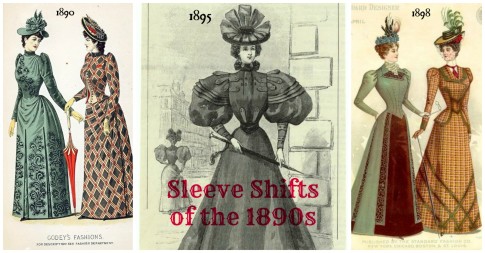
Fashion doesn’t change overnight.
There’s a subtle movement when a new thought is presented. The idea is taken to the full extreme over a period of a few years. Then it seems to be discarded quickly; put on the shelf and forgotten. Another new idea is presented and we start the cycle again.
This path is quite defined by what we see sleeves doing from about 1890 to 1899. This 10-year period took a tightly fitted sleeve and ballooned it to puffs that would be big enough for that afternoon snooze head rest. Then they deflated and promptly become manageable again.
Let’s take a gander at how the sleeve changed from the Late Bustle Era through the defining element of the final Victorian decade.
Please note: picture heavy post with lots of fashion plates.
“Oh, I AM grateful,” protested Anne. “But I’d be ever so much gratefuller if—if you’d made just one of them with puffed sleeves. Puffed sleeves are so fashionable now. It would give me such a thrill, Marilla, just to wear a dress with puffed sleeves.”
“Well, you’ll have to do without your thrill. I hadn’t any material to waste on puffed sleeves. I think they are ridiculous-looking things anyhow. I prefer the plain, sensible ones.”
“But I’d rather look ridiculous when everybody else does than plain and sensible all by myself,” persisted Anne mournfully.”
If anything defines the 1890s it’s Anne and Marilla’s conversation. Ridiculous over sensible. Excess over budget. Dreams over reality.
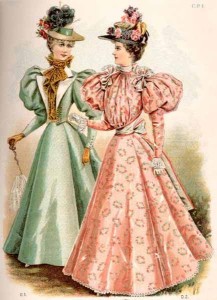
The 1890s decade had heavy influence from the early 1830s but more tailored and chic and less frou-frou Romantic. Women were infiltrating men’s work and becoming into their own.
“The movement, in which she figured so prominently, produced during most of the decade a style of dress at once aggressive and guarded – pugnacious in a prudish fashion. This spirit was grafted on to modes alleged to be ‘Early Victorian.’ The huge sleeves of 1830, deprived of their romantic effusion, became in the ‘90s side-arms defending the female who marched between them.” Chapter X, English Women’s Clothing in the Nineteenth Century by C. Willett Cunnington
As we get into the yummy fashion plates of the era let’s cover a few basics in sleeves.
In general, gigot and leg o’ mutton sleeve were the common cut of sleeves. They were set high onto the shoulder (one reason to help support the shape staying up) and most often mounted to a fitted lining. Fabric could be cut on the grain or cross, gathered or pleated into the armhole, be tight along the forearm, and could be accented in a long or short cuff.
1889 & 1890 Years
In the early years, sleeves were often cut in two fabrics – one for the puff and one for lower part on the forearm. The “Italian Sleeve” presented a full puff above the shoulder then tight down the length of the arm. A double sleeve of a loose cut upper portion (think bishop sleeve) that tightened at the elbow and over a long tight sleeve to the wrist. Cuffs were very wide.
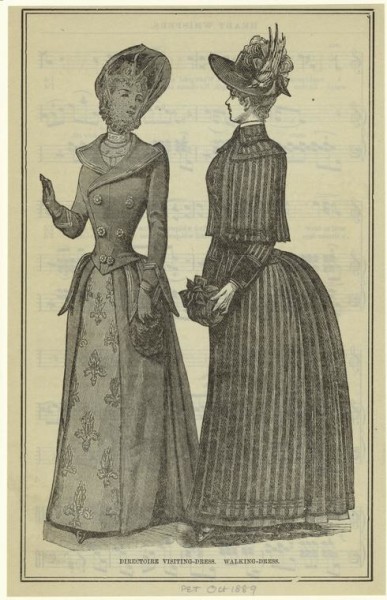
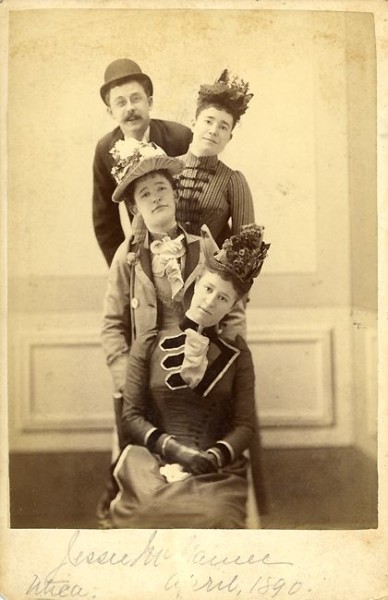
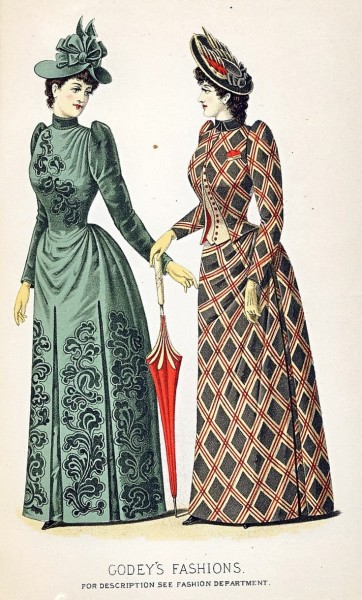
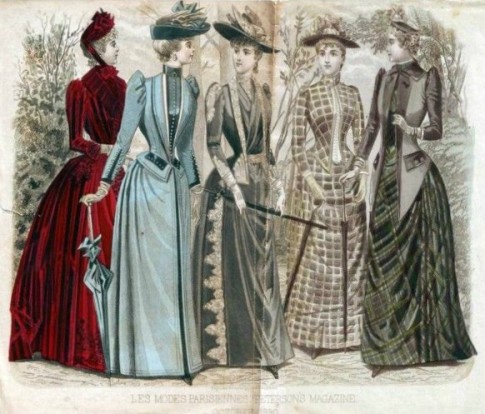
1891-1892 Years
As we move forward, the larger leg o’ mutton shape was cut with one seam along the inner arm and the fullness pleated (knife or box) or gathered into the armhole to create width at the shoulders but not height. The purpose was to make the waist look small. (See? All an illusion.)
1892 saw a widening of the shoulder line with sleeves getting larger and pelerine collars added such as seen in the late 1820s. Armhole seams sat on the shoulder – not dropped at all. And we see lots of V-shaped inserts on the outer part of the sleeve.
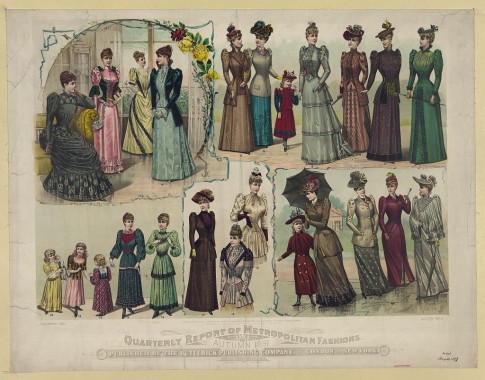
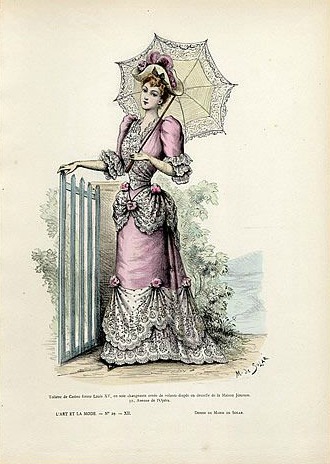
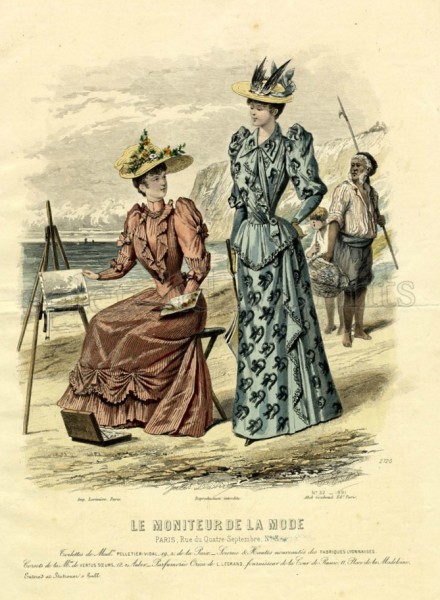
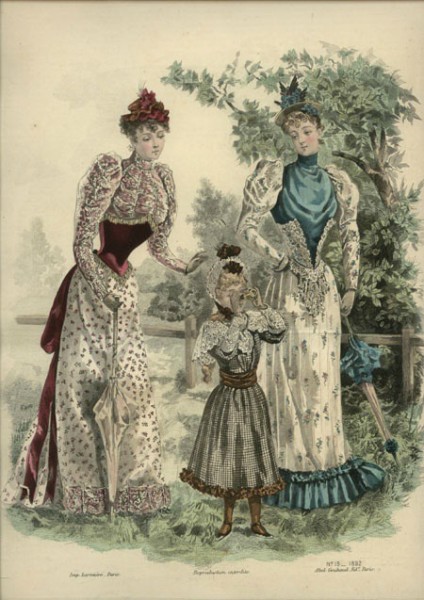
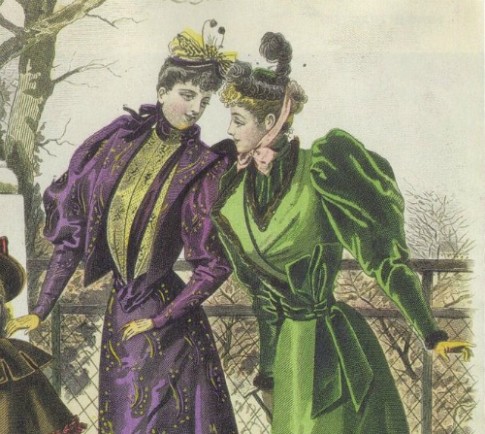
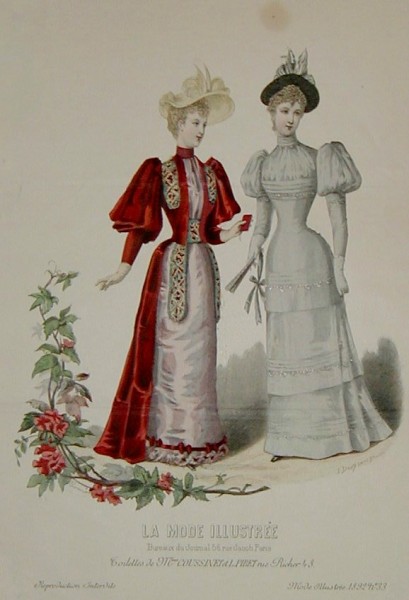
1893-1894 Years
The mid-90s years saw the explosion of the sleeve shape. (Are we at ridiculous yet??).
The influence from the early 1830s was noticeable. The large puff was allowed to fall more loosely and more fullness was seen at the elbow. Fashion dictated that the sleeves were to be “pulled out and not up.” Variations of the Garibaldi and bishop sleeve styles were adapted.
“Everyone may wear garments of any period or none provided they have big sleeves and revers of frills on their bodices.” Section on 1893, English Women’s Clothing in the Nineteenth Century.
In 1894 the fashion changed but it did not progress. The styles looked about the same as what 1893 produced. The gigot sleeves were still hugely puffed, and the silhouette defined to indicate a tiny waist.
Double puffs and immense bishop sleeves were seen too. The sleeves oftentimes were cut from the skirt fabric. And not just cut huge, the sleeves were often trimmed with ribbons, laces, could include pleating and tucks or gathered into design seams within the sleeve puff, and worn with or without cuffs.
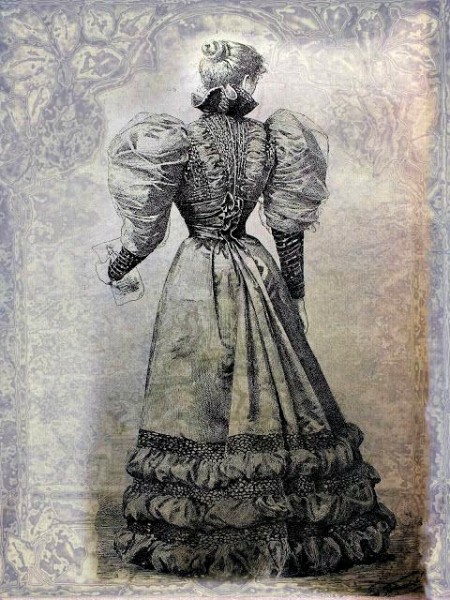
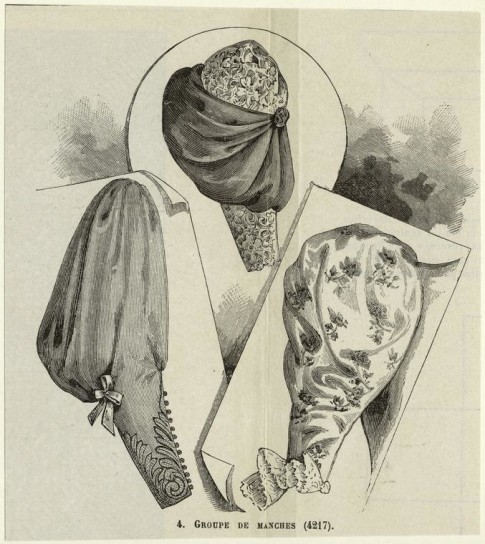
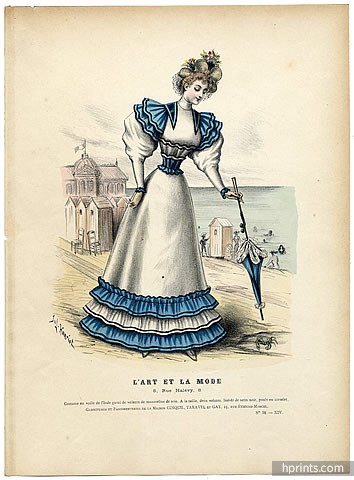
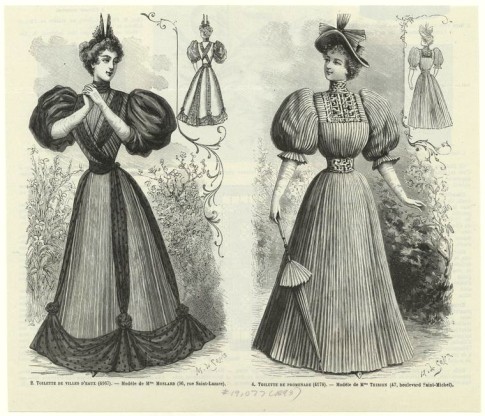
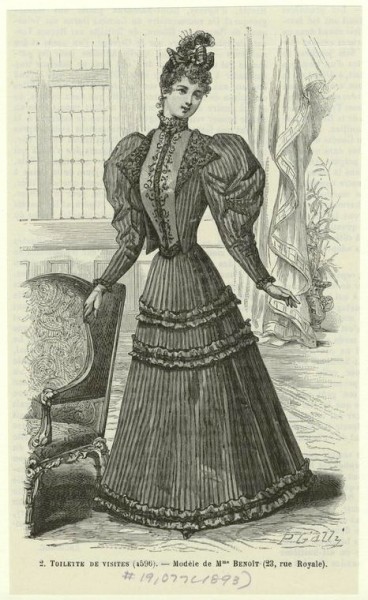
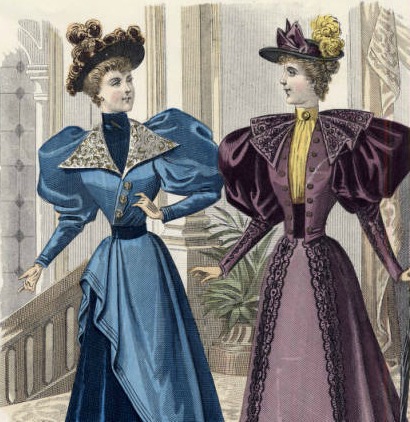
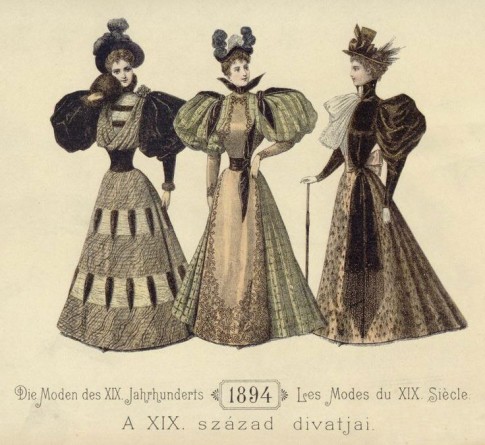
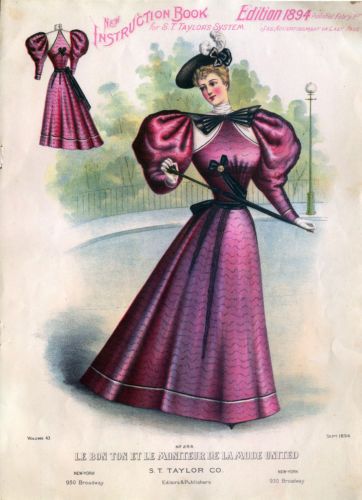
1895-1896 Years
Somehow the sleeves became even larger in 1895. They were stuffed with down, stiffened muslin or small steels. (Take a look at these 1890s sleeve supports and these.) “Monstrous” was the description.
Sleeves still seen in double puffs, or brought in at the elbow, or a wide bishop shape down to the wrist. Oversleeves, tucks and bands all present on the large puffs. Epaulettes of lace and frills frequently topped our enormous gigot sleeve.
In 1896 the size of the upper puff was shrinking (thank goodness!); the bottom of the pouf above the elbow was starting to be pulled into the arm and retreating toward the shoulder.
The sleeve was collapsing and fast!
Almost like the elbow was tired of being hidden and overpowered so it forced down the puff above it which reduced the cut width as well. They became close fitting with smaller shoulder puffs which could be cut in contrast fabric on the straight or cross. The appearance was to produce length rather than width now.
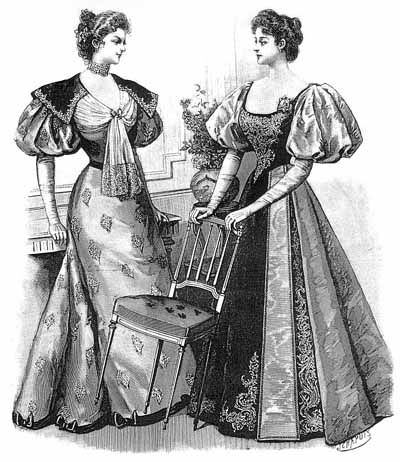
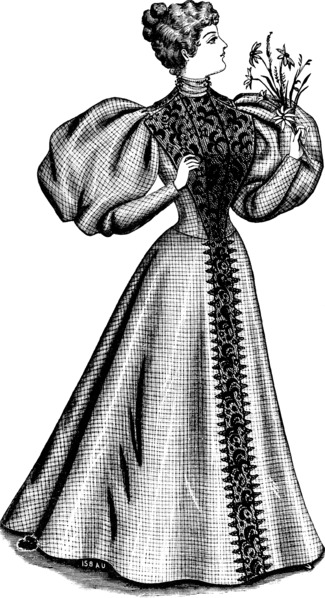
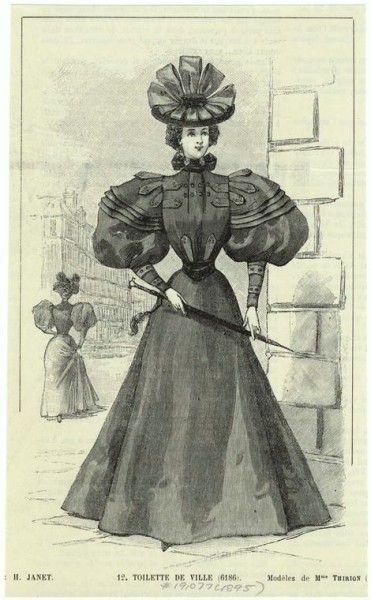
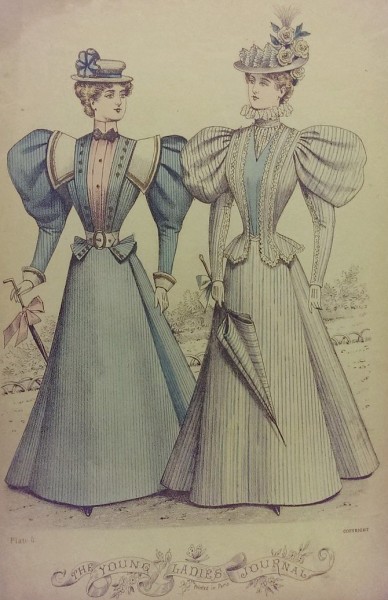
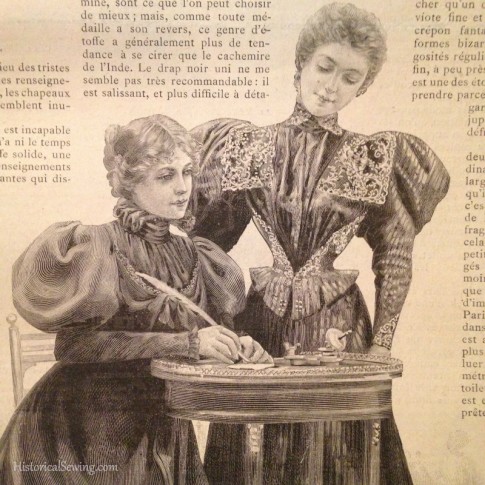
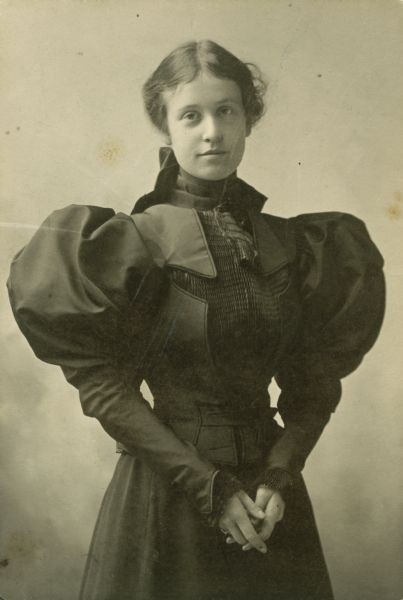
1897-1898 Years
Fluffy and frilly and a new change of style appeared in 1897. Girly-ness and femininity was back! The shrunken sleeves reduced the top-heavy look. It was a much smaller puff, single or double over a close fitting sleeve. The puff itself was trimmed or tucked or ruched. Epaulettes were still popular.
By the time 1898 rolled around it was a period of refining the new sleeve styles introduced in the previous year. They are still tight fitting with small single or double puffs at the shoulders. But even then, the puffs were diminishing still.
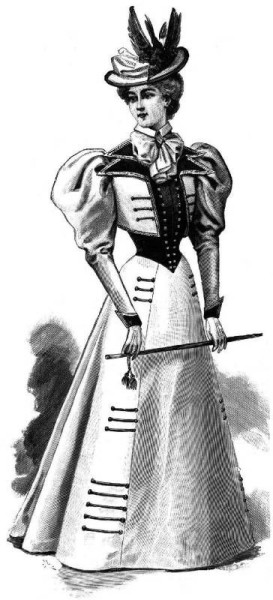
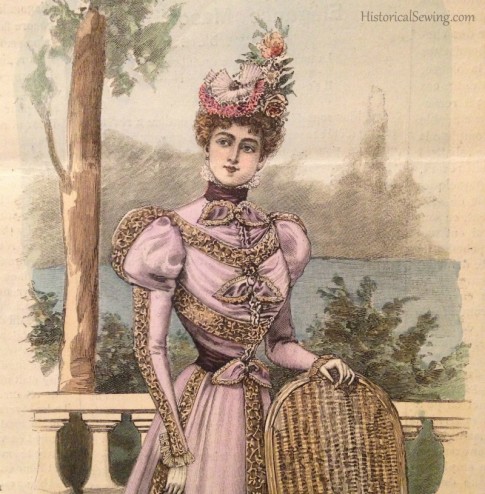



1899 Year
As we finish out our research of shifting sleeve shapes, we can take note of the well-reduced shoulder puff – quite small but still defined in some bodices – to merely a straight, tight-fitting sleeve from shoulder to wrist. In many instances the sleeves fall over the hand.
The focus has moved off the sleeves and to the hips now. Gone are Anne’s puffiest of puffed sleeves.
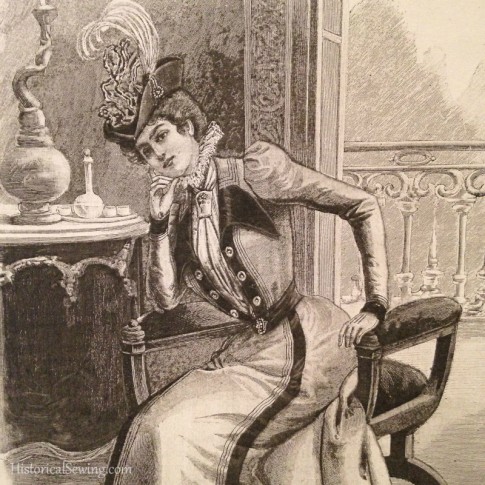



Although the sleeve was a defining garment feature in the 1890s it is surprising to see how quickly it ballooned from 1889 to 1893 (that’s only four years) then deflated just as fast down to a small puff by 1897.
The more I study this fabulous costume decade the more I find nuances that intrigue and delight. My favorite year is 1898 – I ADORE the fashions then as the Victorian Era was changing and making way for the new Edwardian Era. For more research and studying antique garments too visit my Pinterest board for the 1890s decade.
Do you research 1890s fashion? Have you made and worn these puffed sleeve styles Anne would be delighted over?

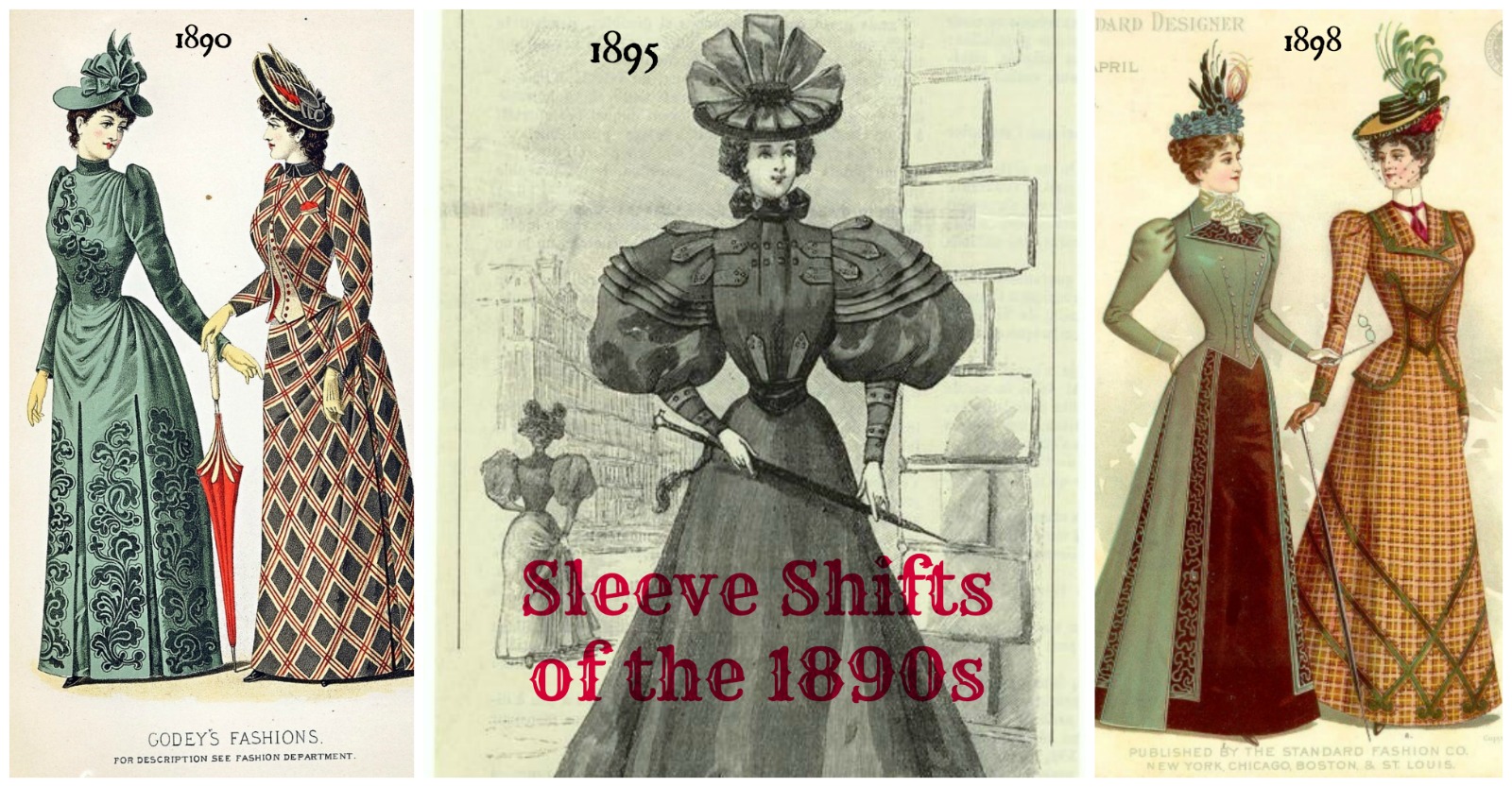
Hi, I was wondering which of the images in the 1893-4 and 1895-6 sections are bishop sleeves. They all just look like gigot sleeves to me
In general, a bishop sleeve is full from top to bottom, and the bottom brought in close to the arm to finish but it’s not tight along the length of the sleeve. A gigot is the large puff then tight/form-fitting on the arm below the puff. The bottom two of the 1893 Groupe de Manches are bishop variations; the right dress of 1893 Promenade Toilettes shows bishop style. Then, 1891 L’Art et la Mode is a bishop style, as are both from 1891 from Le Moniteur de la Mode.
What are “modesty sleeves”? I am sewing a pattern that calls for them,but since the top is velvet and not sheer, I wonder if I need them. Thank you for your expertise. Loved the article.
Kathleen
Depends on the era/time period. Is your pattern for 1890s? For that decade I’d think “modesty sleeves” are the inside, fitted sleeve lining where the outer fashion fabric is gathered/pleated and mounted to over the lining ones. But not entires sure here. If for mid-19th Century, I’d say they are the undersleeves that fill in the wide bell fashion sleeves.
How did they keep the puffs puffed? You mentioned stuffing. I wonder how that worked without sagging. Or did they starch the material??
We’ll see a variety of construction techniques for holding out those huge sleeves. Many were underlined with stiff fabric such as organdy, tarlatan, or other stiff mesh type of textiles. I don’t believe I’ve ever heard of starching bodices, only the undergarments. Ruffles could be applied on the inside of the sleeve, between the fitted inner sleeve and the puffed outer one to hold the shape. Although not used often, small stuffed pads could be sewn into the sleeve head as well.
The 1895 puffs are my absolute favorite of this puffed sleeve era…when I was small I desperately wanted enormously puffed sleeves! (Though my favorite all-time costumes of the period are the mid to late 1850s.)
I always wondered how groups of women went anywhere in 1986 without dismantling everything, or knocking their friends over.
Thanks for this timely post! Between the pics in the article and the ones on the linked Pinterest page, I’ve been able to pin down the date of a lovely antique velvet bodice I just splurged on to the early 1890’s – 1891 or 2 at the latest, I’m willing to bet, It’s so lovely to gaze at, and gently pet, and is a fantastic reference piece for construction, but I do so wish that the shop’s owner hadn’t pointed out that it looks to be exactly my size! I’d never have even thought of trying it on otherwise, and the temptation to do so is getting stronger every day. Should I give in, I’ll post pics on the Facebook group! 😉
AND … what kind of coat or outerwear could you fit over those sleeves? I think they deflated because they requires new everythng – new coats and cloaks, new wider carriages, deeper closets.
Yes, new coats with the same large sleeves were needed too. Short capes, however, came into fashion as an easy outerwear garment that draped over the large sleeves without having to shape around them.
I like the hardware they contrived to hold up the sleeve pouffs.
And there was enough fabric in an 1894 sleeve to make a dress for a small girl.
This one tip will greatly help when I start working on my 90s dress: “They were set high onto the shoulder (one reason to help support the shape staying up)… “.
I wished I’d read this before I made my white blouse but I learn as I go.
Val
Yep! If you study the original bodices many of them have quite narrow shoulder seams (which sat closer to the top of the shoulder at this point in time). That armhole seam does not hang off at all and is more ON the shoulder. Makes perfect sense in how it works to hold up all that sleeve fabric.
As an actor playing the roles of both Marmee and Aunt March in various productions of Little Women, I frankly love the puffed sleeves. The costuming for Little Women is set in the Civil War era, when the sleeve was tight and the shoulder line dropped below the natural shoulder. VERY restrictive for movement! Those roomy puffed sleeves would have been a breath of fresh air (literally) compared to the fashions of the American Civil War!!
You’re right, these remind me so much of Anne and her longing for puffed sleeves! Some of those sleeves are so large that they overwhelm with the wearer’s head. When the sleeves finally deflated, did they just remove the sleeves and put new ones in or maybe just cut them to fit the later fashion? Maybe both?
Could be both; there was certainly enough fabric in those large ones to cut down to size.
Who dreams up these ridiculous fashions? They are lovely to look at now but must have been wholly impractical for daily life. None of the women with those huge sleeves look as though they ever held an infant to that shoulder. I like to look at and read about fashions in the past but can not understand them. Who said one needed to have the look of a tiny waist? How can women be thought of as rational creatures when they let themselves be decked out in clothes that restrict movements. The illustrations also play into the belief of many that women laced extremely tightly to achieve the small waist. I confess to being as guilty as anyone of wanting to be in fashion. Having a child cured me of almost all of that .
I can see the reason why there was a Rational dress society.
I do like your pictures and comments but have never been able to under stand the hold fashion has on all of us.
Because humans want to connect with each other. To conform and be part of a collective society. Clothing allows us to feel this connection and it allows us to express our individuality while still looking like we belong. It’s how we are created. 🙂
And women knew that the male animal was attracted to a woman with a certain hip to waist ratio. I’m not defending it, that’s just how it was, and in modern fashion, still is.